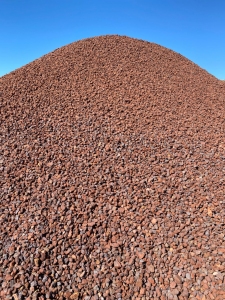 Products Products |
IRON ORE: Iron ores are rocks and minerals from which metallic
iron can be economically extracted. The ores are usually rich in iron oxides and vary in color from
dark grey, bright yellow, deep purple, to rusty red. The iron itself is usually found in the form of
magnetite (Fe3O4), hematite (Fe2O3), goethite (FeO(OH)), limonite (FeO(OH).n(H2O)) or siderite
(FeCO3). Hematite is also known as "natural ore", a name which refers to the early years of mining,
when certain hematite ores containing up to 66% iron could be fed directly into iron-making blast
furnaces. Iron ore is the raw material used to make pig iron, which is one of the main raw materials
to make steel. 98% of the mined iron ore is used to make steel. Indeed, it has been argued that iron
ore is "more integral to the global economy than any other commodity, except perhaps oil.? |
COAL: Coal is a readily combustible black or
brownish-black sedimentary rock normally occurring in rock strata in layers or veins called coal
beds or coal seams. The harder forms, such as anthracite coal, can be regarded as metamorphic rock
because of later exposure to elevated temperature and pressure. Coal is composed primarily of carbon
along with variable quantities of other elements, chiefly sulfur, hydrogen, oxygen and
nitrogen[citation needed].
Coal begins as layers of plant matter accumulate
at the bottom of a body of water. For the process to continue the plant matter must be protected
from biodegradation and oxidization, usually by mud or acidic water. The wide shallow seas of the
Carboniferous period provided such conditions. This trapped atmospheric carbon in the ground in
immense peat bogs that eventually were covered over and deeply buried by sediments under which they
metamorphosed into coal. Over time, the chemical and physical properties of the plant remains
(believed to mainly have been fern-like species antedating more modern plant and tree species) were
changed by geological action to create a solid material. |
MANGANESE ORE: Manganese is a chemical element, designated
by the symbol Mn. It has the atomic number 25. It is found as a free element in nature (often in
combination with iron), and in many minerals. As a free element, manganese is a metal with important
industrial metal alloy uses, particularly in stainless steels. Manganese phosphating is
used as a treatment for rust and corrosion prevention on steel. Depending on their oxidation state,
manganese ions have various colors and are used industrially as pigments. The permanganates of
alkali and alkaline earth metals are powerful oxidizers. Manganese dioxide is used as the cathode
(electron acceptor) material in standard and alkaline disposable dry cells and
batteries. Manganese(II) ions function as cofactors for a number of enzymes in higher
organisms, where they are essential in detoxification of superoxide free radicals. The element is a
required trace mineral for all known living organisms. In larger amounts, and apparently with far
greater activity by inhalation, manganese can cause a poisoning syndrome in mammals, with
neurological damage which is sometimes irreversible.
|
NICKEL: is a chemical element, with the chemical symbol Ni
and atomic number 28. It is a silvery-white lustrous metal with a slight golden tinge. It is one of
the four elements that are ferromagnetic around room temperature, the other three being iron, cobalt
and gadolinium.
The use of nickel has been traced as far back as 3500 BC,
but it was first isolated and classified as a chemical element in 1751 by Axel Fredrik Cronstedt,
who initially mistook its ore for a copper mineral. Its most important ore minerals are laterites,
including limonite and garnierite, and pentlandite. Major production sites include Sudbury region in
Canada, New Caledonia and Norilsk in Russia. The metal is corrosion-resistant, finding many uses in
alloys, as a plating, in the manufacture of coins, magnets and common household utensils, as a
catalyst for hydrogenation, and in a variety of other applications. Enzymes of certain life-forms
contain nickel as an active center, which makes the metal an essential nutrient for those life
forms.
|
COPPER: is a chemical element with the symbol Cu (Latin:
cuprum) and atomic number 29. It is a ductile metal, with very high thermal and electrical
conductivity. Pure copper is rather soft and malleable, and a freshly exposed surface has a pinkish
or peachy color. It is used as a thermal conductor, an electrical conductor, a building material,
and a constituent of various metal alloys.
Copper compounds are commonly
encountered as salts of Cu2+, which often impart blue or green colors to minerals such as turquoise
and have been used historically widely as pigments. Copper metal architectural structures and
statuary eventually corrode to acquire a characteristic green patina. Copper as both metal and
pigmented salt, has a significant presence in decorative art.
Copper(II)
ions (Cu2+) are soluble in water, where they function at low concentration as bacteriostatic
substances, fungicides, and wood preservatives. In sufficient amounts, copper salts can be poisonous
to higher organisms as well.
|
CHROME ORE: is an iron chromium oxide: FeCr2O4. It is an
oxide mineral belonging to the spinel group. Magnesium can substitute for iron in variable amounts
as it forms a solid solution with magnesiochromite (MgCr2O4); substitution of aluminium occurs
leading to hercynite (FeAl2O4). The only ore of chromium is the mineral chromite. The two main
products of chromite refining are ferrochromium and metallic chromium, for those products the ore
smelter process differs considerably. For the production of ferrochromium the chromite ore (FeCr2O4)
is reduced with either aluminium or silicon in a aluminothermic reaction and for the production of
pure chromium the iron has to be separated from the chromium in a two step roasting and leaching
process.
Chromite is also used as a refractory material, because it
has high heat stability.
| 
| |
|
|

